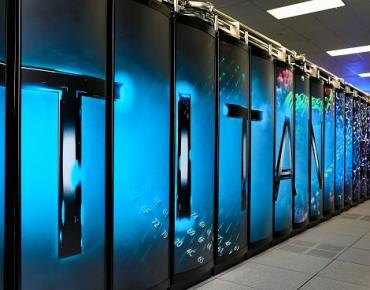Titan Puts a New Spin on GE’s Wind Turbine Research

While wind may not account for the majority of the world’s energy anytime soon, the amount of fast-growing energy it produces is expected to leap from 2.5 percent to 12 percent in the next six years alone. But unlike traditional energy sources, wind is a trouble to tame, which has led GE to turn to advanced simulations to put the technology on track to meet its 2020 goal.
As Masako Yamada, a computational scientist at GE Global Research, explains, a primary concern with wind turbines is cold weather, particularly in northern Europe and Canada, or areas of high altitude in the U.S. and China, where wind is readily available but particularly difficult to harness.
“Many of the regions in the world that could benefit from wind energy are actually in cold climates,” Yamada says. “If you have ice on a turbine, it reduces the efficiency of energy generation, and depending on the severity, you may have to shut down the turbine completely.”
To combat this, Yamada is working as a principal investigator alongside Azar Alizadeh, co-principal investigator, and Brandon Moore, a former GE researcher who is now at Sandia National Laboratories, to better understand the interaction between ice formation and turbine coatings that could have an ice-phobic effect.
With the help of the Department of Energy’s (DOE) ASCR Leadership Computing Challenge award, GE is using the hybrid CPU/GPU Cray XK7 Titan supercomputing at Oak Ridge Leadership Computing Facility (OLCF) at Oak Ridge National Laboratory (ORNL) to get a closer look on hundreds of millions of water molecules freezing onto these surfaces in slow motion.
Turbines already in these high altitude or high latitude areas often rely on heaters installed in the blades to melt the ice before it accumulates, but the heaters alone drain between three and five percent of the energy the turbine produces. But with wind energy estimated to reach a market potential of $100 billion by 2017, GE is motivated to find away around the turbines’ icy drawback.
In fact, GE started its anti-ice experiment back in 2005. Since then, it’s determined that heat and mechanical force are not the only ways to keep turbines ice-free. Instead, engineers working on new blades can rework their design to resist ice buildup in the first place, which requires no extra energy expenditure. These surfaces work by lowering the freezing point of water, low down the freezing process, repelling water before it can cling to the blade and freeze, or by reducing ice’s adhesive qualities.
But that doesn’t mean GE is out of cold water yet.
“Freezing is a really complicated process,” Yamada says. “What we found experimentally is that surfaces that are great icephobic surfaces at one temperature may not be as effective at a different temperature.”
To combat this, Yamada and her team wanted to look at the freezing process at an atomic level to see exactly what initiates the process. But in a regular experimental setup, by the time researchers could use visual or thermal signatures to detect freezing, the moment of interest had passed. “In an experimental setup they can only really figure out the general region where ice starts freezing,” she says.
But GE’s simulations offered a leg up as soon as they boosted the size of the system (to handle individual molecules rather than entire droplets) as well as the temporal resolution (to give researchers more stages of the freezing process to examine).
The result was a computational challenge that was without precedent. As Yamada explains, most molecular dynamic studies are still in the 1,000-molecule range. “We needed a million molecules per droplet to even be able to start,” Yamada says.
And that was far from the whole challenge.
“One droplet is not meaningful because we wanted to come up with a landscape correlating freezing and the surface of the blade,” she says. “So we needed hundreds of droplets.”
This meant that GE would require a petaflop super at the absolute minimum. With the DOE’s ALCC award of 40 million hours, the company turned to ORNL’s Jaguar first, then in 2012 to Titan, with its peak performance of 27 petaflops.
The result of the boost was an increase from testing ice formation on three surfaces at three different temperatures to testing six surfaces at five different temperatures, which meant carrying out eight times the simulations of the original estimate.
With the help of the OLCF staff, these were turned in to visualizations of exactly how and where ice begins. “The visualizations helped us realize where the nucleus starts,” Yamada says. “Are there multiple independent nuclei that fuse together or are there finger-like regions that spread out, for example.”
“We’ve come to understand there’s no one-size-fits-all solution,” she continued. “I think I can go back and say that for temperatures between -10 and -20, this type of solution you want. For -30 to -40, try this type of solution. So now we can figure out the knobs that you have to turn to make things go this way or that way.”
Beyond cutting down on experimentation on future wind turbines and other infrastructure sensitive to ice formation, GE’s work has several other applications in store. The team has been granted a new ALCC award for its anti-ice research, which Yamada says should include an additional variable of thermal conductivity to help find even better solutions for GE’s products of the future.










